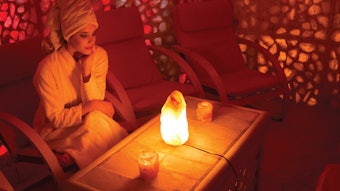
Consumers are pursuing wellness more than ever before. According to a recent report by the Global Wellness Institute (GWI), “The COVID-19 pandemic has accelerated the ascendance of wellness as a dominant consumer value all around the world. Consumers are increasingly aware that all aspects of their lives—where they live; how they work; what they eat; and how they exercise, socialize and travel—impact their health outcomes, mental resilience and overall sense of well-being.” Evidence to support this statement is so compelling that the GWI projects that for the next five years, the global wellness economy will grow at a robust rate of 9.9% annually and will reach nearly $7.0 trillion in 2025. This is an extremely encouraging shift in societal awareness and priorities, as it will certainly promote further interest in wellness-based treatments and services within the spa and hospitality industries.
Log in to view the full article
Consumers are pursuing wellness more than ever before. According to a recent report by the Global Wellness Institute (GWI), “The COVID-19 pandemic has accelerated the ascendance of wellness as a dominant consumer value all around the world. Consumers are increasingly aware that all aspects of their lives—where they live; how they work; what they eat; and how they exercise, socialize and travel—impact their health outcomes, mental resilience and overall sense of well-being.” Evidence to support this statement is so compelling that the GWI projects that for the next five years, the global wellness economy will grow at a robust rate of 9.9% annually and will reach nearly $7.0 trillion in 2025. This is an extremely encouraging shift in societal awareness and priorities, as it will certainly promote further interest in wellness-based treatments and services within the spa and hospitality industries.
The spa industry must be prepared with programs, treatments and services that not only meet this need, but complement each other to provide optimal benefits and a satisfying and relaxing experience. Light therapy absolutely fits in here as an integral component to a well-thought-out and immersive experience. It’s well known to shine not only as a stand-alone treatment, but also to help amplify the benefits of other services, like massage, sauna, body scrubs, wraps and just about every skin care treatment. Because of its anti-inflammatory and pain-relieving benefits, it also has significant value when offered before and after exercise, including hiking, yoga, fitness training, tennis or anything after which muscle soreness may occur.
Defining Light Therapy
LED therapy, red light therapy, low level laser therapy—you’re probably familiar with most if not all of these terms, as they’re all associated with a technology that’s been used to rejuvenate the skin and promote wellness in spa settings for many years.
The newest and official Medical Subject Heading (MeSH) term, adopted by the National Library of Medicine, is photobiomodulation (PBM). After upwards of 70 names, this one seems the most appropriate: “photo” meaning light; “bio” meaning biology; and “modulation” meaning to control or regulate. Hence, PBM is a therapeutic treatment that regulates biological processes with light. This kind of treatment uses very low levels of light-based energy that is essentially transferred to the body’s cells, where it’s able to fuel important cellular processes and trigger beneficial signaling cascades.
PBM is also referred to as low level light therapy (LLLT). This therapy is most often used to promote tissue healing, relieve pain and modulate inflammation, but more recent studies have shown improvements in cognition, memory and even mood. It does this by providing support that enables tissues to heal, maintain and better protect themselves.
Supporting the Body’s Inherent Wisdom
In the absence of genetic mutations or injuries, most young people heal, regenerate and defend with relative ease. Their bodies are quite efficient at managing the vast and complex molecular processes necessary for maintenance and repair. As we age, these processes can get derailed by cumulative cellular damage associated with a lifetime of exposure to things that create oxidative stress and promote inflammation.
Light therapy has been shown to counteract these issues and support the body’s inherent wisdom, or competence, in the following ways:
- Increases production of ATP, the body’s cellular fuel source.
- Helps build proteins like collagen and elastin for plumping and firming the skin.
- Upregulates the production of growth factors for healing and repair.
- Increases bioavailability of nitric oxide, a signaling molecule that’s critical to regulating endothelial, cognitive and immune function, among many other things.
- Increases antioxidant enzymes.
- Reduces oxidative stress and inflammation.
- Improves circulation, delivering more oxygen, nutrients and immune cells throughout the body.
- Activates endogenous stem cells to heal and repair tissues.
- Relieves pain, addressing the cause and the sensation.
When the body has the resources it needs to behave in a more productive and youthful way, it tends to follow suit. This is also true of a healthy diet, regular exercise, adequate sleep, stress management, and a good physical and social environment, all of which make the most of the body’s intricate and brilliantly capable molecular mechanics to promote well- being and longevity.
In addition, more competent cells mean higher functioning tissues and organs, including the body’s largest organ: the skin. Regarding facial services, you can think of light therapy as something that not only addresses what we see on the skin’s surface as a result of what’s not working so well on a deeper level, but as a treatment that actually intervenes at the cellular level to promote changes and prevent many of those visible signs of aging from occurring. Because of the way in which light therapy jumpstarts beneficial cellular processes, we generally see both immediate and long-term improvements in the skin.
Right away, light therapy helps increase microcirculation to oxygenate the skin while stimulating lymphatic cells and local fluid circulation. This can produce immediately visible effects that include a vibrant, healthy glow, smoother skin texture and reduced edema or puffiness.
With more regular use, light therapy can increase pro- collagen, collagen and elastin for plumping, firming and smoothing wrinkles, and it can encourage multiple growth factors for tissue repair and healing. In terms of prevention, light therapy decreases the production of matrix metalloproteinases (MMPS), which are enzymes that degrade collagen and elastin. So, this therapy is not only for mature skin and existing wrinkles, it also optimizes skin function and prevents environmentally induced damage at any age.
Delivering Mind/Body Experiences
There are a number of ways to offer light therapy to spa guests. Full face, stand-alone devices can be used to enhance the benefits of facial services. This can be done on clean, dry skin or with compatible serums and masks. Light therapy works well with topical products that hydrate and nourish the skin for an even softer and more radiant result.
Full body LED treatment can be used to improve blood flow while warming and relaxing tissues—great for preparing the guest for a massage. It can also provide pain relief and muscle relaxation after exercise, which may make it possible for guests to participate in more healthy and enjoyable activities throughout their stays at wellness-centered properties.
Keep in mind that some of the benefit comes from the relaxation factor. Light therapy promotes neurotransmission that results in calming and soothing effects. This is something to consider when choosing a device, as well: continuous wave (CW) lights, i.e., LEDs that don’t flash, are generally preferred to pulsing or flashing options, because they promote relaxation rather than excitability. And this, of course, is more in line with the experience that spa-goers seek.
With the right light therapy technology, guests will enjoy a peaceful mind in harmony with a nurtured body.
Amy Gardner is a licensed and oncology trained esthetician, educator and director of education at LightStim, where she has curated the company’s educational content for more than 11 years. Having immersed herself in the study of light therapy during this time, Gardner is an internationally sought-after speaker within the skin care, medical and wellness communities.










